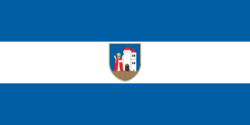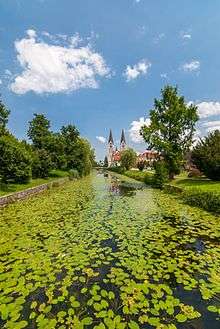Kočevje
| Kočevje | |
|---|---|
| City | |
|
The Rinža River in Kočevje | |
 Kočevje Location of the City of Kočevje in Slovenia | |
| Coordinates: 45°38′34.66″N 14°51′33.78″E / 45.6429611°N 14.8593833°ECoordinates: 45°38′34.66″N 14°51′33.78″E / 45.6429611°N 14.8593833°E | |
| Country |
|
| Government | |
| • Mayor | Vladimir Prebilič |
| Area | |
| • Total | 14.14 km2 (5.46 sq mi) |
| Elevation[1] | 465 m (1,526 ft) |
| Population (2012)[2] | |
| • Total | 8,616 |
| • Density | 610/km2 (1,600/sq mi) |
| Time zone | CET (UTC+01) |
| • Summer (DST) | CEST (UTC+02) |
 | |
| Use | Municipality wide flag |
|---|---|
| Proportion | 1:2 |
| Adopted | 28 June 1999[3] |
| Design | A horizontal tricolor of blue and white, defaced with the coat of arms of Kočevje. |
Kočevje (pronounced [kɔˈtʃeːu̯jɛ]; German: Gottschee;[4] Göttscheab or Gətscheab in the local Gottscheerish dialect; Italian: Cocevie) is a city in the Municipality of Kočevje in southern Slovenia. It is the seat of the municipality.
Geography
The town is located at the foot of the Kočevski Rog karst plateau on the Rinža River in the historic Lower Carniola region. It is nowadays part of the Southeast Slovenia Statistical Region.[5]
Name
Kočevje was attested in written sources in 1363 as Gotsche (and as Gotsew in 1386, Kotsche in 1425, and propre Koczeuiam in 1478). The name is derived from *Hvojčevje (from hvoja 'fir, spruce'), referring to the local vegetation. The initial hv- changed to k- under the influence of German phonology. Older discredited explanations include derivation from the hypothetical common noun *kočevje 'nomadic settlement' and Slovene koča 'shack'.[6] The former German name was Gottschee.[4]
History
In 1247 Bertoldo de Merania, Patriarch of Aquileia, granted the area around Ribnica within the Imperial March of Carniola to the Carinthian counts of Ortenburg. When the counts had received further estates in 1336 on the wooded plateau down to Kostel on the Kolpa River from the hands of Patriarch Bertram, they called for German-speaking settlers from Carinthia and Tyrol. In the following decades they established the town of Gottschee, which was first mentioned in a 1363 deed. The settlement received market rights in 1377 and town privileges in 1471.
Until 1918, the town was part of the Austrian Empire (and part of Cisleithania after the Austro-Hungarian Compromise of 1867), in the district of the same name, as one of the 11 Bezirkshauptmannschaften in province of Carniola.[7] The German name alone was used by the post office before 1867.[8]
After the Second World War, a Yugoslav labor camp for political prisoners operated in Kočevje until March 1946.[9]
Germans of Kočevje
They first settled in Carniola around 1330 from the German lands of Tyrol and Carinthia and maintained their German identity and language during their 600 years of isolation. They cleared the vast forests of the region and established villages and towns. In 1809, they resisted French occupation in the 1809 Gottscheer Rebellion. With the end of the Habsburg Monarchy in 1918, Gottschee became a part of the new Kingdom of Yugoslavia. The Gottscheer thus went from being part of the ruling ethnicity of Austria-Hungary (and the ruling group in the estates of the province of Carniola itself) to an ethnic minority in a large Slavic state. With the onset of the Second World War and the Invasion of Yugoslavia their situation was worsened further.
Landmarks
The parish church in the city is dedicated to Saint Bartholomew (Slovene: Sveti Jernej) and belongs to the Roman Catholic Diocese of Novo Mesto. It is a Neo-Romanesque building erected between 1887 and 1903 on the site of an earlier church.[10]

Flag
The flag of Kočevje is a tricolor consisting of three equal horizontal bands displaying the colors of Kočevje: blue and white, defaced with the coat of arms.[11] The association with the colors blue and white surfaced around 1470s when Emperor Frederick III (cesarja Friderika III) approved the design of the coat of arms, along with civic rights. on 19 April 1471. The flag during that time varies from the one seen today. The old flag was a bicolor of blue and white, defaced with the coat of arms which was also different at the time.
Notable people
Notable people that were born or lived in Kočevje include:
- Stane Jarm (1931–2011), sculptor, graphic artist and teacher (worked in Kočevje)
- Matej Bor (1913–1993), poet and author (worked in Kočevje)
- Milan Butina (1923–1999), academy-trained painter, art teacher, art theorist (born in Kočevje)
- Ivan Jurkovič (born 1952), apostolic nuncio to Russia (born in Kočevje)
- Zofka Kveder (1878–1926), writer (worked in Kočevje)
- Alois Loy (1860–1923), longtime mayor of Kočevje
- Viktor Parma (1858–1924), composer (worked in Kočevje)
- Roman Erich Petsche (1907–1993), teacher, painter, and Righteous Among the Nations (born in Kočevje)
- Michael Ruppe (1863–1951), professor and academy-trained painter (worked in Kočevje)
- Franjo Uršič (1898–?), geologist and teacher (worked in Kočevje)
Bibliography
- Karl-Markus Gauß: Die sterbenden Europäer. Unterwegs zu den Sepharden von Sarajevo, Gottscheer Deutschen, Arbëreshe, Sorben und Aromunen. Zsolnay, Wien 2001, ISBN 3-552-05158-9 (Taschenbuchausgabe: dtv, München, ISBN 3-423-30854-0)
References
- ↑ "Nadmorska višina naselij, kjer so sedeži občin" [Height above sea level of seats of municipalities] (in Slovenian and English). Statistical Office of the Republic of Slovenia. 2002.
- ↑ "Kočevje, Kočevje". Place Names. Statistical Office of the Republic of Slovenia. Retrieved 6 September 2012.
- ↑ "Kočevje (Municipality, Slovenia)". Retrieved 26 October 2015.
- 1 2 Leksikon občin kraljestev in dežel zastopanih v državnem zboru, vol. 6: Kranjsko. 1906. Vienna: C. Kr. Dvorna in Državna Tiskarna, p. 36.
- ↑ Kočevje municipal site
- ↑ Snoj, Marko. 2009. Etimološki slovar slovenskih zemljepisnih imen. Ljubljana: Modrijan and Založba ZRC, p. 193.
- ↑ Klin, Wilhelm. 1967. Die postalischen Abstempelungen auf den österreichischen Postwertzeichen-Ausgaben 1867, 1883 und 1890.
- ↑ Mueller, Edwin. 1961. Handbook of Austria and Lombardy-Venetia Cancellations on the Postage Stamp Issues 1850–1864.
- ↑ Mrvič, Irena. 1999. "Taborišče." Enciklopedija Slovenije, vol. 13 (Š–T), pp. 177–179. Ljubljana: Mladinska knjiga, p. 179.
- ↑ Slovenian Ministry of Culture register of national heritage reference number 1564
- ↑ "Grb in zastava" [The coat of arms and flag] (in Slovenian). Retrieved 26 October 2015.
External links
| Wikimedia Commons has media related to Kočevje. |
- Website of the Municipality of Kočevje
- Kočevje: map and basic data. Geopedia.si.
- Pre–World War II list of Kočevje residences, occupations, and family names (1–39)
- Pre–World War II list of Kočevje residences, occupations, and family names (40–140)
- Pre–World War II list of Kočevje residences, occupations, and family names (144–326)
- Pre–World War II list of Kočevje residences, occupations, and family names (332–344, unnumbered)
